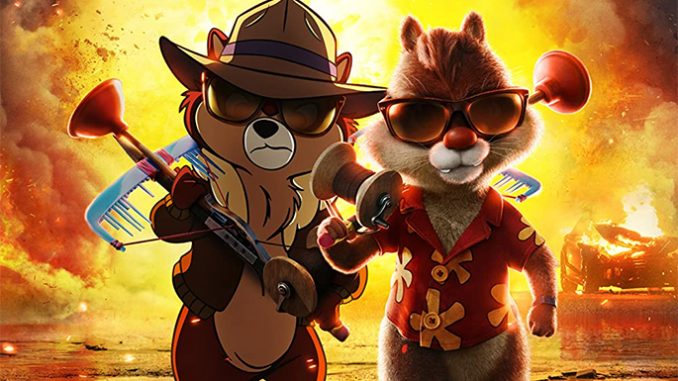
Distribution Service: Disney+
MPAA Rating, PG
CSM Rating, 6+
Reel Rating: 3 out of 5 reels
Disclaimer: Spoilers Ahead
In the late 1980s, the Walt Disney company launched their first cable network, The Disney Channel, designed for affluent households filled with children eager for around the clock cartoons. To entice subscribers, Freshman CEO Michael Eisner tried something revolutionary: parental nostalgia. Rather than invent original characters, he rebranded old properties with exciting new shows. The characters from The Jungle Book became Tailspin, Donald Duck and company headlined DuckTales, and two acorn-loving rodents formed Chip and Dale: Rescue Rangers.
None of these shows were enormous hits, rarely going past a second season, but they made a lasting impression on their Millennial audience. Now Hollywood finds itself in the second round of nostalgia; thus, we have the 2022 feature length reboot of this serial reboot. The result is certainly “fun”—although that’s the most enthusiasm that can be mustered for its limited audience.
Chip and Dale borrows a trope from Roger Rabbit, imagining a universe in which cartoon characters are real actors living alongside humans. Chip and Dale were once big stars, but after the cancellation of their series they quickly became has-beens. Chip (John Mulany) survives the aftermath well as a successful insurance salesman. Dale (Andy Samberg), however, clings to waning fame, getting computer-generated “surgery” and earning a meager income by doing cameos at fan conventions. Estranged because a bad falling out, they must reconcile for one last case after their friend Monty (Eric Bana) is kidnapped.
Many films have leaned heavily on nostalgia and meta-humor (Muppet Treasure Island, Turning Red, etc), but I’ve never seen a picture whose entire existence is based exclusively on these elements. Without a second viewing, I can still remember allusions to South Park, My Little Pony, Gumpy, Beauty and the Beast, James Bond, Indiana Jones, and probably dozens (or hundreds!) more. Many are quite clever, like a poster encouraging toons to vote Beavis from Beavis and Butthead for president, simultaneously lampooning the animated series and Mike Judge’s classic political farce Idiocracy. Others are tired, redundant, or simply boring. The summary effect is a film that feels like an extended SNL skit or YouTube parody rather than a fully formed feature production.
More innovative is the sheer volume of animated styles packed into a single narrative. Rescue Rangers is not the first film to combine traditional, drawn animation and 3D computer characters, but it is the first to do so in a mainstream feature with the styles in obvious contrast. Not only that, it also includes live action actors, motion capture personalities, Claymation, and even a sock puppet. While this brings up odd questions of philosophy and physics (where is the hand animating the sock?), the atmosphere is never confusing. This is a world where nearly anything is possible, and it somehow works.
In this age of social media and constant detraction, every movie is lacking in one way or another. When Rescue Rangers was released, bored Reddit users immediately found fault with the central villain Sweet Pete (Will Arnett). Like Chip and Dale, Peter Pan was a big star until puberty made him unbankable. He descended into a life of crime, creating a business that kidnaps toons and alters them into “bootleg copies” for a quick buck. Aside from the creepy resemblance to human trafficking, fans also found identified similarities to the real-world actor Bobby Driscoll, the voice of Peter Pan in the 1953 Disney original. He too was a child star until Disney cancelled his contract at sixteen. Afterwards, he fell into homelessness and drug addiction. When died of an overdose at thirty-one, he was so forgotten his own mother did not discover his fate until more than a year later.
The claim is that the filmmakers deliberately and maliciously mocked Driscoll with this character. The charge is faulty on two counts. First, the motif of a child star hitting rock bottom is well-established. Furthermore, Peter Pan as the “boy who never grows up” is ripe as a candidate, which was already examined in Spielberg’s Hook. Second, even if the writers were aware of Discoll’s situation, he has been dead for well over sixty years and could hardly take offense. He is but one possible target among dozens in this narrative. As Mel Brooks once quipped, “I’m not prejudiced. I make fun of everyone.” Like so many faux-news stories, this is just clickbait.
It’s difficult to imagine Chip and Dale appealing to a younger audience, and the dark material makes it an even harder sell. Yet as a member of the generation that grew up with these characters, I have to confess that I was amused throughout. There’s value in something that is just fun to watch, even if the overall product is lacking, and this certainly checks that box.
If you value the news and views Catholic World Report provides, please consider donating to support our efforts. Your contribution will help us continue to make CWR available to all readers worldwide for free, without a subscription. Thank you for your generosity!
Click here for more information on donating to CWR. Click here to sign up for our newsletter.




I get it. High on production values, bupkus on human values.
I’m pretty sure there’s a metaphor there for life today.
Well, thanks a lot. I may actually have missed this movie if I had not read this in depth review.
I thought we were boycotting Disney due to their stated intention to insert LGBTQ characters in all their new productions.
All publications occasionally need some “filler” to take up space, and I suppose that was the reason for this article in CWR today.